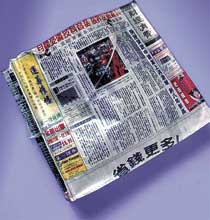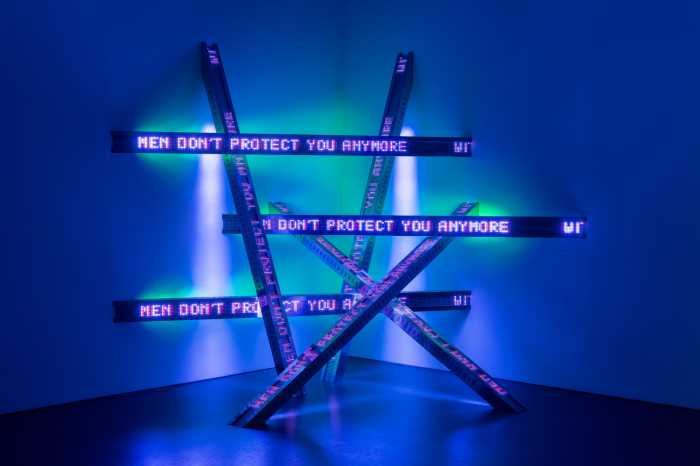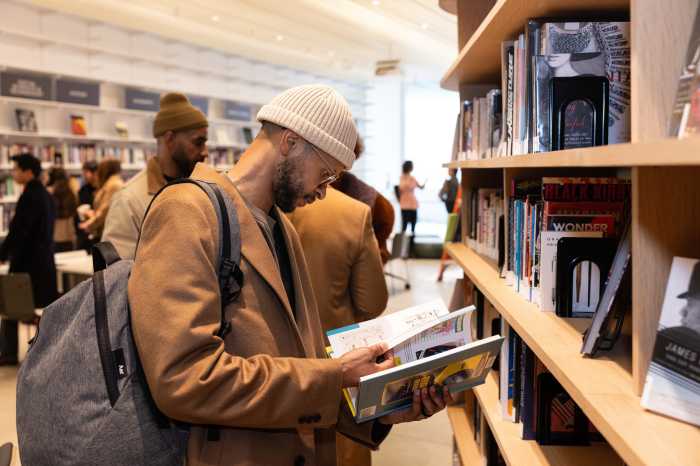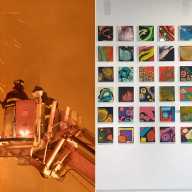Williamsburg resident Maria Capotorto has
the gift of seeing the stylish in the ordinary. To decorate her
apartment, she fashioned a lamp made out of Chinese take-out
boxes, vintage bath mats out of old towels, shower curtains out
of grocery bags and wastebaskets out of, well, waste.
"I just liked messing around with
things. I liked pushing the limits," said Capotorto in a
recent interview in her studio in Manhattan’s fashion district.
The 37-year-old never expected, though,
that her hobby would become big business. Bags she made out of
laminated newspapers now find themselves in boutiques, including
Fred Segal’s, DKNY and Barney’s.
"I was unemployed and bored, so I
got this idea of using items at home as design elements,"
said Capotorto.
She thought it would be kitschy to make
a trash bin out of garbage. "I used old newspapers and made
trashcans," she said. "My friends saw it and found
it cute. Later, they asked me, ’Can you make bags?’ That’s when
the idea was formed."
Two years after its inception, Capotorto’s
company, Your Sister’s Mustache, is on a steady path to success.
The company is named after a family joke – a phrase her mother
used instead of cursing – and it is starting to make money.
Maria collects old publications, and sometimes
she even has to buy them in bulk. She makes regular trips to
Chinatown to get the Chinese papers she uses for her Chinese-print
bags. She, however, no longer has the time to sew them all by
herself. She has the bags produced partially by handicapped workers,
but she still chooses which sides of the newspapers are used.
Once in a while, she throws one big sorting party with a few
friends.
Using different sections of the New York
Times, particularly the Arts, Metro and Sunday Styles sections,
the Pratt Institute industrial design graduate bonded old newspapers
in polyvinyl, sewed them with zigzagged stitches and added straps.
How her homemade projects became urban
accessories is pure serendipity. A friend who wrote for the Times,
Timothy Jack Ward, thought that Capotorto’s pastime was a recycling
idea worth sharing. He sent a photographer to her apartment and
wrote a short article that included Capotorto’s contact information.
"I got like 50 calls from that article.
I had my foot in the door, in places where I never knew my foot
could be in before," she said. With the help of friends,
along with contacts she made because of the January, 1998 article,
Capotorto found herself an agent.
Alan Spigelman, who represents other designers,
became Capotorto’s rep. "Her products were great,"
he said. "I found them clever. Everybody would want them."
But while Spigelman believed in Capotorto’s
products enough to take a chance on her lack of business experience,
success was not instantaneous. Spigelman said he didn’t make
a commission off Capotorto for a while, as she had to get the
bags into production and learn the ropes of the business.
"She makes thousands and thousands
every month," Spigelman proudly said of his discovery’s
success. She has also designed "subway bags" made out
of MTA subway maps; "tacky bags" made out of the National
Enquirer; "retro bags" made out of newspapers from
the ’70s; and "kiddie bags," made out of children’s
books and cartoons. Because Capotorto uses different publications
and sections, each bag is one-of-a-kind.
But being a designer at heart and an entrepreneur
by necessity has been a challenge for the former Herman Miller
furniture designer.
"If I could spend all of my time just
designing, and every other aspect of the business would take
care of itself by itself, I would love that," said Capotorto.
Spigelman agreed: "She is more an
artist than a businesswoman, so she needed to keep up to pace
with a lot of things. She learned quickly."
"I’ve worried about things I never
new existed, like selling and production, and taxes," she
said, almost complaining.
Uncertainty was also something Capotorto
had to face. "I was turning down designing jobs to work
on this project," she said. "I was unemployed and cutting
up newspaper. Of course I asked myself, ’Am I doing the right
thing here?’"
Even her parents were initially concerned
about their daughter’s leap of faith. Although Capotorto’s family
fostered a creative atmosphere – her sisters are writers and
her brother is an actor – her parents were worried when she told
them she was working on laminated newspapers. "My product
is a little tough to explain, so my parents were a little worried.
But now, they’re all very supportive," she said.
Capotorto described the experience of seeing
someone carrying her design for the first time as surreal. She
was having lunch with her boyfriend, when she saw a woman carrying
her tote bag. "I left the restaurant and followed the woman
around for one block," she said.
The designer said she usually checks out
the people she sees carrying one of her bags. "I usually
want to see what kind of people like my stuff," Capotorto
said. "How do they look? What are they wearing? Are they
cool?"
Aside from having her products in high-end
shops, Your Sister’s Mustache also has numerous corporate accounts
with publications.
So what does Capotorto still hope for?
"To come out with a line of more urban
products, including belts, hats, lamps and T-shirts," she
said. Capotorto plans to laminate sex ads from the Village Voice
and make them into belts. She also plans to make polyvinyl hats
out of newspapers, "since people are always covering their
heads with newspapers anyway."
"Oh, and I always have to pray,"
she added, "that it doesn’t rain on recycling day."
Maria Capotorto’s handbags are available
through citystuff.com or Mini Mini Market [218 Bedford Ave.,
(718) 302-9337].

























